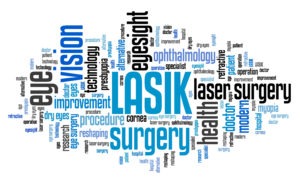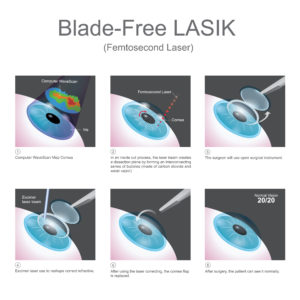The Evolution of LASIK, Understanding the Technology and Terminology
By Carolyn Hebson, M.D.
Cornea, Cataract, & Refractive Surgeon
LASIK is a well-established procedure for the treatment of near sightedness, far sightedness, and astigmatism. To date, over 16 million procedures have been performed worldwide, making LASIK among the most common elective surgeries. LASIK is essentially a three-step, automated, in-office procedure that involves measuring the eye’s prescription, creating a partial thickness corneal flap, and using an excimer laser to reshape the cornea to allow a patient to see well without glasses. This article will discuss the evolution of LASIK technology, iLASIK and iDesign as well as review its terminology.
LASIK flap creation began with the use of a metal blade (microkeratome) to cut a partial thickness corneal flap along with a laser that was manually programmed to treat based on a patient’s glasses prescription. At the time this surgery was revolutionary, but over the past 25 years LASIK has evolved significantly. There are still businesses that continue to offer older LASIK technology at a deeply discounted rate, and when you see an advertisement by a LASIK chain this is the technology you are purchasing. Many consumers are drawn to the lower cost, but there are reasons most surgeons recommend modern LASIK. LASIK flaps created with a metal blade (microkeratome) are more prone to complications such as a buttonhole, freecap, incomplete flap, and even full thickness corneal perforation. In addition, a metal blade (microkeratome) cannot cut the cornea as precisely as a laser which can result in the creation of a deeper or more superficial LASIK flap than what was intended.
Today’s LASIK typically involves the use of an Intralase femtosecond laser to create a partial thickness corneal flap at whatever depth, diameter, and configuration the surgeon programs into the laser. The precision of Intralase has reduced the risk of LASIK flap complications to almost zero and eliminated the possibility of corneal perforation. When LASIK is performed using a laser rather than a microkeratome blade it is differentiated by the term iLASIK, the “i” meaning Intralase LASIK. Using the Intralase femtosecond laser to create a LASIK flap does cost more than a metal blade, but the technology has been studied extensively and numerous clinical trials have shown that it improves both the safety and precision of LASIK flap creation. Because of this, many ophthalmologists now only offer iLASIK to patients, myself included.
After the LASIK flap is created it is lifted by the surgeon and an excimer laser is used to gently reshape the cornea. Conventional LASIK involves taking a patient’s glasses prescription, programming it manually into the laser, and performing the treatment. Glasses prescriptions are not unique as many people can have the sample basic prescription, so there is nothing personalized about conventional LASIK. In addition, conventional LASIK treats lower-order aberrations (nearsightedness, farsightedness, and astigmatism) but not higher-order aberrations, which can cause nighttime symptoms of halo and glare in some patients. Conventional LASIK was revolutionary technology 25 years ago and there are still a few indications for conventional laser treatment today. But customized treatments provide superior visual outcomes and have become the treatment of choice in most scenarios.
Today’s LASIK involves the use of wavefront technology to create a highly customized laser treatment. The wavefront system measures how the eye processes light and generates an intricate, three-dimensional map to treat any imperfections or aberrations. Modern LASIK treats both lower and higher-order aberrations of the eye resulting in clearer vision (often better than 20/20) and fewer nighttime issues.
At VisonFirst, we offer iDesign wavefront technology, which is the most up-to-date treatment available. iDesign acquires 1257 data points in each eye to create the most customized, high definition LASIK treatment to date. iDesign treatments are 25 times more precise than conventional LASIK and 94% of patients are able to see 20/20 or better after surgery. Do you have additional questions about LASIK, Intralase, or iDesign? Schedule a free consultation with us today. We have offices in Birmingham, Alabaster, Homewood and Pell City. The future of LASIK is here and it is better than ever!









